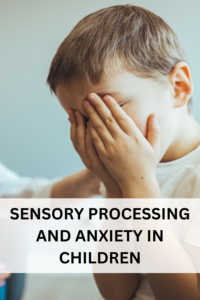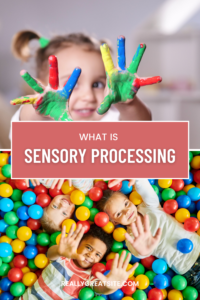
Are you seeking more information on sensory processing and anxiety in children? If so, you’re in the right place!
In a world full of sensory stimuli, from the hum of a refrigerator to the brightness of a computer screen, most children navigate their environments with relative ease, adjusting to sensory input without much thought.
However, for children with sensory processing difficulties, everyday sights, sounds, textures, and movements can be overwhelming, leading to significant challenges in their daily lives.
These challenges are often compounded by anxiety, a natural response to perceived threats or stressors. When sensory processing issues and anxiety intersect, it can create a cycle where one exacerbates the other, leaving children feeling trapped and overwhelmed.

Hi! My name is Marra and I’m a mama and a pediatric occupational therapist who has years of experience working with children with diverse developmental needs and helping their parents navigate the ups and downs of child development.
I loved being a support person for parents learning about child developmewnt, sensory processing, and their child’s individual needs. Understanding the intricate relationship between sensory processing and anxiety is crucial for parents, educators, and therapists alike.
By recognizing the signs of sensory processing difficulties and their impact on a child’s emotional well-being, we can take steps to support these children more effectively.
This blog post will delve deeply into the link between sensory processing and anxiety in children, explore why sensory processing difficulties can lead to heightened anxiety, and provide you with practical, actionable tips to help your children manage both sensory challenges and anxiety.

The Link Between Sensory Processing and Anxiety in Children
Sensory processing is a complex neurological process that allows us to make sense of the world around us. Our brains receive and interpret sensory information from our environment through our senses—sight, sound, touch, taste, smell, vestibular, proprioceptive, and interoceptive senses.
For children with typical sensory processing, this information is organized and integrated in a way that allows them to respond appropriately to their surroundings.
However, for children with sensory processing difficulties, this process can go awry, leading to either hypersensitivity (over-responsiveness) or hyposensitivity (under-responsiveness) to sensory stimuli.
Anxiety, on the other hand, is an emotional state characterized by feelings of worry, nervousness, or fear, often in response to stress or perceived threats.
While some level of anxiety is normal and even beneficial in certain situations, chronic or excessive anxiety can be debilitating, affecting a child’s ability to function in everyday life.
When sensory processing difficulties and anxiety intersect, the result can be a complex and challenging experience for the child. The following are key reasons sensory processing and anxiety in children could be linked

6 Reason sensory Processing and Anxiety in Children May be Linked
Overstimulation and Sensory Overload
For a child with sensory processing difficulties, the world can be an overwhelming place. Everyday environments such as busy classrooms, crowded stores, or noisy playgrounds can bombard them with sensory input—bright lights, loud noises, strong smells, and varied textures—all at once.
When a child’s brain struggles to filter and organize this input, it can lead to sensory overload, a state where the nervous system becomes overwhelmed by too much information.
This overstimulation can trigger a fight-or-flight response, leading to intense feelings of anxiety. The child may feel trapped, unable to escape the sensory chaos, which further heightens their anxiety.
Unpredictability and Fear of the Unknown
Children with sensory processing difficulties often have a heightened need for predictability and routine. Sudden changes in their environment and sensory input, such as an unexpected loud noise, a surprise touch, or a shift in daily routine, can be extremely distressing and frightening to them.
These unpredictable sensory experiences can cause the child to feel unsafe and anxious, as they are unable to anticipate and prepare for what might happen next. The fear of the unknown can lead to a constant state of hypervigilance, where the child is always on edge, bracing for the next sensory assault.
Difficulty Filtering Sensory Information
Some children with sensory processing difficulties struggle to filter out irrelevant sensory information. For example, in a classroom setting, they might hear the hum of the air conditioner, the rustling of papers, the tapping of pencils, and the teacher’s voice all at the same volume, making it difficult to focus on the task at hand.
This inability to filter can lead to a sense of chaos and confusion, contributing to feelings of anxiety. The child may feel overwhelmed by the sheer amount of sensory input, leading to difficulty concentrating, irritability, and a heightened state of anxiety.

Social Challenges and Anxiety
Sensory processing difficulties can significantly impact a child’s social interactions. For example, a child who is hypersensitive to touch might avoid playing with peers for fear of being accidentally bumped or touched.
A child who is hyposensitive to sound might struggle to hear and follow conversations, leading to misunderstandings and social isolation. These challenges can make it difficult for the child to form and maintain friendships, leading to feelings of loneliness and anxiety about fitting in.
The social anxiety that results from these sensory challenges can further exacerbate the child’s overall anxiety levels.
Fear of Sensory Experiences
Children who have had negative sensory experiences in the past may develop anxiety around similar situations in the future. For example, a child who finds certain textures distressing may become anxious about encountering those textures again, leading them to avoid certain activities, foods, or environments.
This avoidance behavior can limit the child’s experiences and opportunities for learning and growth, reinforcing their anxiety over time.

Impact on Self-Esteem and Confidence
Children with sensory processing difficulties may struggle with tasks that seem easy for their peers, such as buttoning a shirt, holding a pencil, or sitting still in class. These struggles can lead to frustration and a sense of inadequacy, affecting the child’s self-esteem and confidence.
Over time, the child may develop anxiety about their abilities and become fearful of trying new things, further limiting their potential and reinforcing the cycle of anxiety.
10 Tips for Parents to Help Their Child Manage Sensory Processing and Anxiety
Sensory processing difficulties and anxiety in children can be challenging However, there are many strategies you can use to help your child navigate these obstacles and build resilience. The following tips are designed to provide practical support for managing sensory processing issues and reducing anxiety:
Create a Sensory-Friendly Environment
One of the most effective ways to help your child manage sensory processing difficulties is to create a sensory-friendly environment at home. This might include designating a quiet, calming space where your child can retreat when feeling overwhelmed.
Soft lighting, calming colors, and familiar objects can create a sense of safety and comfort. Consider using blackout curtains, noise-canceling headphones, or white noise machines to reduce sensory input in the environment.
By providing a safe space where your child can relax and recharge, you can help them feel more in control of their sensory experiences.
Establish Predictable Routines
Consistent routines can help reduce anxiety by providing a sense of control and predictability. Children with sensory processing difficulties often feel more secure when they know what to expect.
Establishing a daily routine that includes regular meal times, playtime, and bedtime can help your child feel grounded and reduce anxiety.
Additionally, preparing your child for transitions and changes in routine can minimize anxiety. Use visual schedules, timers, or social stories to help your child understand what will happen next and how to prepare for it.
Practice Deep Breathing and Relaxation Techniques
Teaching your child simple relaxation techniques can help them manage anxiety when sensory input becomes overwhelming. Deep breathing exercises, progressive muscle relaxation, and visualization techniques can all be effective tools for calming the nervous system.
For example, you can teach your child to take slow, deep breaths in through their nose and out through their mouth, imagining that they are blowing out a candle. Practicing these techniques regularly can help your child develop self-regulation skills and reduce anxiety in stressful situations.
Use Sensory Tools and Strategies

Sensory tools can be invaluable for helping your child regulate sensory input and reduce anxiety. Consider providing your child with noise-canceling headphones to block out loud noises, fidget toys to help them focus, or a weighted blanket to provide calming deep pressure input.
Other sensory strategies, such as offering a variety of textures for tactile exploration or providing opportunities for movement breaks, can also help your child manage sensory challenges.
Work with an occupational therapist to develop a personalized sensory diet that includes activities and tools tailored to your child’s unique sensory needs.
Encourage Regular Physical Activity
Physical activity is a powerful tool for reducing anxiety and improving sensory processing. Engaging in activities that provide proprioceptive input, such as swimming, jumping on a trampoline, or playing with sensory-rich toys, can help regulate the nervous system and promote a sense of calm.
Additionally, regular exercise can improve mood, increase energy levels, and reduce stress. Encourage your child to participate in activities they enjoy, whether it’s riding a bike, climbing at the playground, or dancing to music

Practice Mindfulness and Grounding Techniques
Mindfulness exercises can help your child stay grounded and reduce anxiety by focusing on the present moment. Simple mindfulness activities, such as paying attention to their breath, listening to the sounds around them, or engaging in mindful coloring, can help your child manage sensory-related anxiety.
Grounding techniques, such as focusing on the sensation of their feet on the ground or holding a comforting object, can also be effective for reducing anxiety in overwhelming situations. Practicing these techniques regularly can help your child develop resilience and a greater sense of control over their anxiety.
Provide Positive Sensory Experiences
Gradually introducing your child to sensory experiences they might find challenging in a controlled, positive way can help desensitize them to certain stimuli and reduce anxiety.
For example, if your child is sensitive to certain textures, you can start by allowing them to explore those textures in a safe and enjoyable context, such as during a favorite activity or with a trusted adult. Over time, this can help your child build tolerance to sensory input and reduce their fear of certain experiences.
Support Social Skills Development
Social interactions can be particularly challenging for children with sensory processing difficulties, but with the right support, they can learn to navigate these situations more confidently.
Encourage your child to participate in social activities that are sensory-friendly and aligned with their interests. This might include small-group playdates, sensory-friendly events, or activities that involve structured interaction, such as playing board games or engaging in cooperative play.
Providing opportunities for positive social experiences can help your child build confidence and reduce anxiety related to social interactions.
Seek Professional Support
Working with professionals who understand sensory processing and anxiety in children can be immensely helpful for both you and your child.
An occupational therapist with expertise in sensory integration can develop a personalized sensory diet and provide strategies for managing sensory challenges and anxiety.
Additionally, a child psychologist or counselor can offer support for managing sensory processing and anxiety in children and developing coping skills. Don’t hesitate to seek out professional support if you feel that your child’s sensory processing difficulties and anxiety are impacting their quality of life.
Be a Calm and Supportive Presence
Your calm and reassuring presence can have a significant impact managing sensory processing and anxiety in children.. Validate your child’s feelings, acknowledging that their sensory experiences and anxieties are real and important.
Offer comfort and reassurance, and work together to find solutions when your child feels overwhelmed. By modeling calm behavior and providing a safe, supportive environment, you can help your child develop the confidence and resilience they need to navigate sensory processing and anxiety.
Understanding the connection between sensory processing and anxiety in children is essential for providing effective support. Children with sensory processing difficulties face unique challenges that can make the world feel overwhelming and anxiety-provoking.
However, with the right tools, strategies, and support, parents can help their children navigate these challenges, reduce anxiety, and build resilience.
By creating a sensory-friendly environment, establishing predictable routines, and using practical strategies to manage sensory input, parents can empower their children to feel more in control of their sensory experiences and emotions, decreasing the negative impacts that sensory processing and anxiety in children..
Sensory processing and anxiety in children may be challenging, but with patience, understanding, and the right support, children can learn to thrive and develop the confidence to face the world with greater ease.
